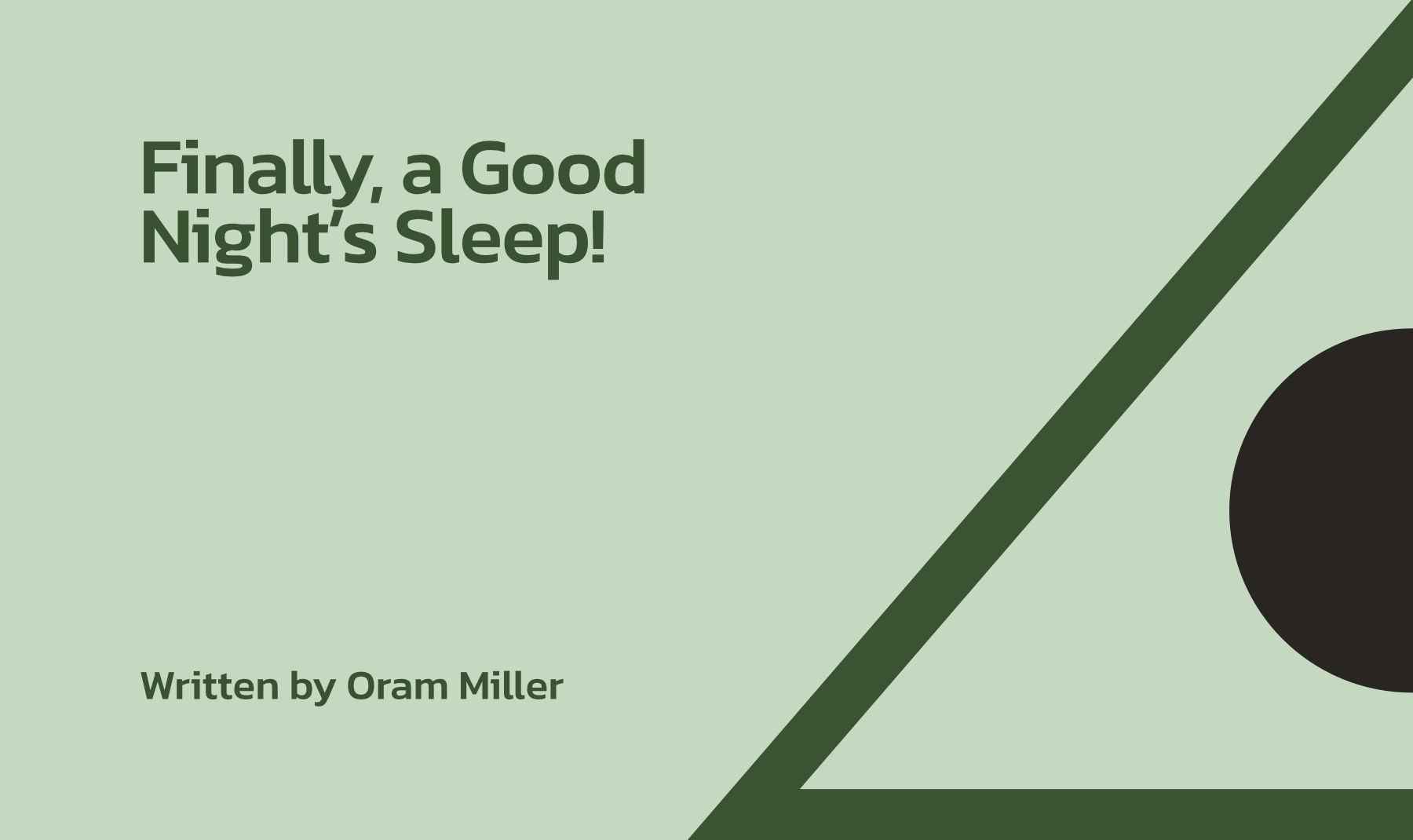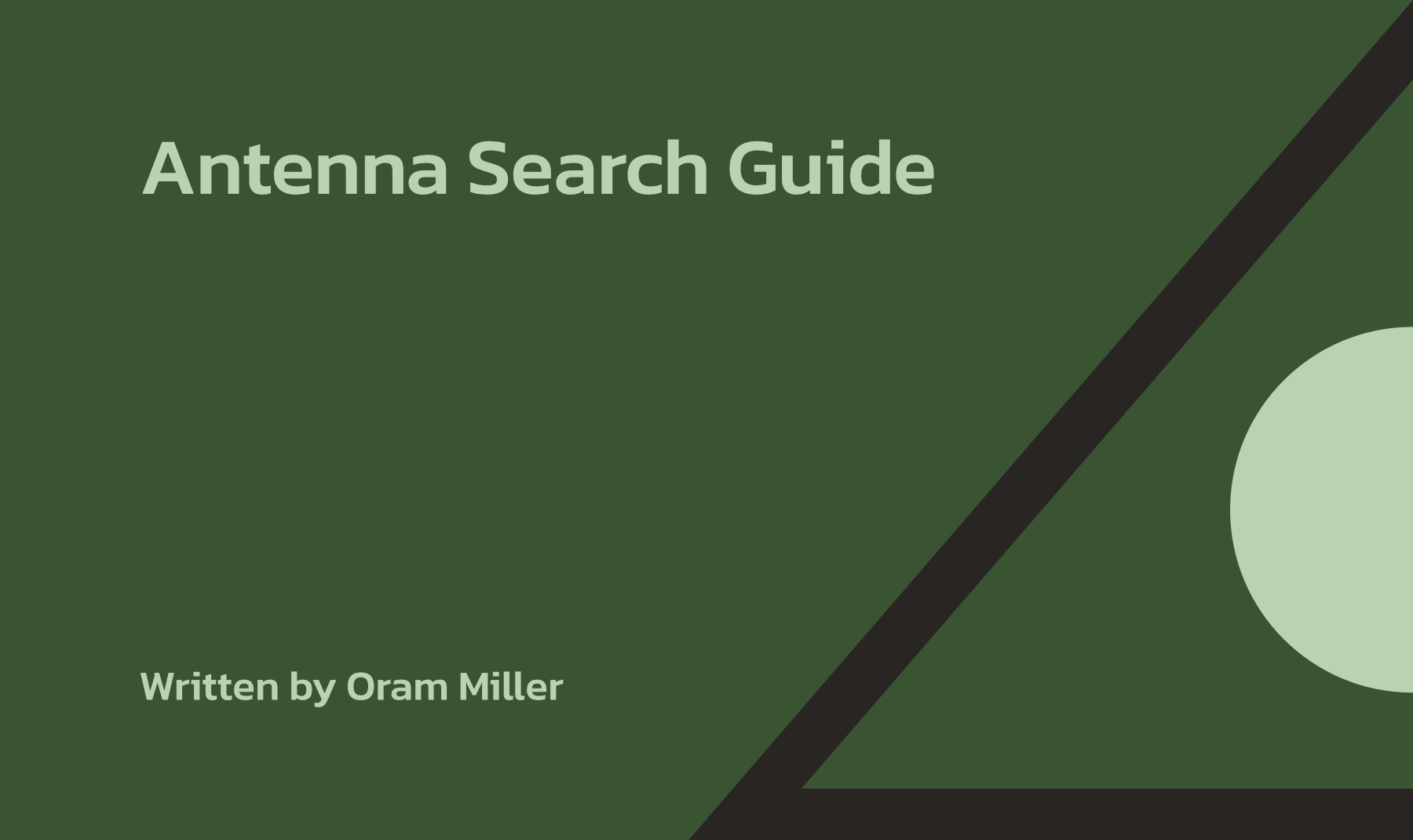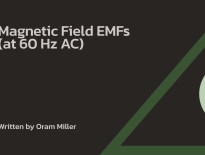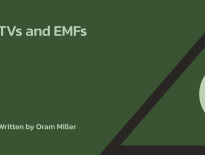Introduction
You can be exposed to potentially harmful radio frequencies from multiple sources both outside as well as inside a building. Outside sources include broadcast radio and television antennas, cellular telephone antennas mounted on towers and buildings, other broadcast antennas (police, fire, airport radar), and now, neighborhood wireless Internet (Wi-Fi) antennas on utility poles. Cell antennas emit RF frequencies using third-, fourth-, fifth- and soon, sixth-generation technologies.
Sources of Radio Frequencies
The most common sources of wireless frequencies in and around your home include wireless Internet (Wi-Fi) routers, cell phones, cordless telephones, and now, smart electric, water and gas meters mounted outside or inside your home. All of these sources can generate pulsed digital frequencies that produce a harmful influence that is not well tolerated by the human physiology. Their presence in a building produces a subtle but harmful effect on the natural bio-electric processes of the body, causing stress and reducing our internal energy and vitality.
The Composition of Wireless Device Radio Waves
Wireless devices, such as cell phones, cordless phones, and Wi-Fi, all operate on carrier waves in the microwave range of the RF, or radio frequency, band. What most people do not realize, however, is that there is a second frequency present in all wireless transmissions that actually carries the voice or computer information data. This second frequency is not even in the radio frequency band. Rather, it is way down in what is known as the Extra Low Frequency, or ELF, band, similar to brainwaves and house wiring (between 30 and 3,000 Hertz or Hz).
This second type of frequency present in all wireless communications is known as “low frequency information-carrying radio wave”, or LFICRW. These were the actual frequencies used by the military in the 1950s, according to Dr. George Carlo, to carry a radio operator’s voice to forces on the battlefield. The frequencies used were 16 Hz and 291-230 Hz. Brainwaves, by comparison, are generally in the 1-40 Hz range. AC house wiring in North and South America is 60 Hz (50 Hz in the rest of the world).
The problem with using low frequency information-carrying radio waves for communication is that while any transmission at these frequencies can carry an abundance of information, their energy is very weak because the wavelength is so long. As a result, the signal does not carry very far before dying out. Therefore, the frequencies did not travel far enough to get to the battlefield, and the Army almost abandoned the technology.
Cell technology was salvaged when Army engineers devised a way to superimpose these low frequency information-carrying radio waves at 16 Hz and 219-230 Hz onto much faster radio waves in the microwave range, at the upper end of the radio frequency band, carry far. That way, the voice could be carried for miles.
When civilian companies adopted this technology and began making and selling cell phones, they had to use this same approach. The frequencies sold to civilian cellular carrier companies in this country today by the Federal Communications Commission, or FCC, for carrier waves are 600 MegaHerz (MHz), 700 MHz, 850 MHz, 900 MHz, 1,800 MHz, 1,900 MHz, and 2,100, 2,300 and 2,500 MHz (the latter are also designated 1.8, 1.9, 2.1, 2.3 and 2.5 GHz, or GigaHertz).
Fourth Generation, or 4G, cellular frequencies from 600 to 1,000 MHz (0.6 to 1 GHz) are in what is known as the “low band”. You will also find low band 5G cell service at 600 and 850 MHz.
Cell frequencies, on the other hand, from 1 GHz to 2.5 GHz for 4G service and from 3.5 to 4.2 GHz for 5G service are all considered to be in what the cellular industry calls the “mid band”.
5G service starting at 20 GHz is considered to be in the high, or millimeter Wave, band. This includes frequencies auctioned to cellular carriers in the U.S. at 28 and 39 GHz. For a detailed discussion of 5G and 4G cellular technology, see my separate 5G article on this website.
By piggy-backing low frequency information-carrying radio waves onto much faster carrier waves in the microwave range, we have two waves transmitting simultaneously, one on top of the other, from cell tower to cell phone and from cell phone back to cell tower. Likewise, the same is true for two-way communication between a cordless telephone base unit and the handset you hold next to your ear, or from your Wi-Fi-enabled router to your laptop and back again. Dr. George Carlo says, think of it like a clothesline with heavy, wet diapers flapping in a stiff breeze at one fast frequency, while the whole clothesline undulates up and down at a second, much slower frequency. It is the same clothesline but with two frequencies.
Frequencies in the microwave range have lower information-carrying capacity but much more power and can therefore radiate for miles. They cannot themselves, however, carry voice or data information to any great extent. Thus we have the need for two frequencies, one superimposed upon the other. The problem is, we only hear about the heating, thermal frequencies, not the low frequency information-carrying radio waves. Why is this so? To answer that, we have to understand how the FCC determined its safe exposure guidelines and how the industry and governmental regulatory agencies handled this research in the first place.
Health Effects
Now that you understand a little history of the development of cell technology and the resultant composition of radio waves transmitted and received by wireless devices, you will better understand the potential health effects that wireless devices cause over the long term, including research not known to most people in the U.S.
It turns out that the two frequencies that make up wireless communications have very different health effects. Long term exposure to frequencies in the microwave range, which are the carrier waves for cellular, cordless phone and Wi-Fi communications, primarily cause thermal or heating effects in human (and animal and plant) cells. They interfere with protein synthesis, among other thermal effects.
The FCC’s safe exposure guidelines, which I discuss below, on the other hand, only take these thermal effects into consideration. They set their safe exposure limits in 1997 at the point where only heating effects begin to occur in tissues. No consideration was made for any health effects that do occur well below that power density level on a biological, non-thermal or non-heating basis.
There is what is known as the Specific Absorption Rate, or SAR, for cell phone use. The SAR is a measure of how much thermal energy a cell phone user’s cells and tissues absorb near the phone, which for most people is the head and neck (and now we have reports from Israel of a worldwide increase in the incidence of head and neck tumors in young people; click here). Below that supposedly safe SAR threshold, cell phones are considered safe. For that reason, cell manufacturers claim their phones cause no adverse health effects.
The research and clinical experience of millions of cell phone users is painting a completely different picture. While there continue to be health effects on the thermal level for many people below the official SAR of 1.6 Watts per kiloGram, especially for children (because the SAR was only set for a 200 lb. adult man), the primary cause of ill health from cell phones is now believed to be from long-term exposure to these low frequency information-carrying radio waves, which are not considered by researchers and also not discussed by the media.
It is the non-thermal (or a-thermal), non-heating, complex biological effects now emerging that are so troubling to researchers, clinicians and public health experts, particularly in Europe. They predict, and are already seeing, a health crisis emerging particularly in young people, that they know their governments will have to pay for through their national health plans. Hence the urgent action by European officials to educate their public and curtail the use of wireless devices throughout the European Union. Research citations are listed below.
Specifically, pulsed, digital frequencies cause harm to cell membranes and inhibit their ability to take in nutrients and give off waste products. When cells are exposed to these low-frequency pulsed digital frequencies, a cascade of events occurs within the membrane, causing it to close down, resulting in “membrane sensitivity syndrome.”
As a result, premature cell death and formation of tumors can occur (see BioInitiative Report). This can cause, among other effects:
- “DNA damage and non-repair,
- opening of the blood-brain barrier (allowing toxins and pathogens to reach the brain),
- lowered immunity,
- decreased melatonin levels,
- effects on stress proteins (indicating cell damage),
- formation of micro-nuclei (aberrations in cell nuclei which are often markers for cancer),
- changes in calcium metabolism affecting communication between cells,
- changes in brainwave patterns as seen on EEG’s,
- plus effects observed on many different systems of the body” (From Latitudes.org)
The net effect of long-term exposure to cell phones, cordless telephones and Wi-Fi routers is disruption of normal physiological processes, causing ill health in tissues and organs. Health effects from these low-frequency waves are cumulative, and there is no safe exposure level or “Specific Absorption Rate” (SAR), as there is with carrier waves in the microwave range.
Long-term effects from use of wireless devices is reported to include memory loss, “brain fog,” headache, fatigue, insomnia, attention deficit disorder, ringing in the ears, and numbness, among other symptoms. The Toronto Women’s College Hospital is reportedly the first hospital to officially recognize what they call Electro-magnetic Hyper-sensitivity syndrome, or “EMS” (others refer to it as “EHS”), that includes the very symptoms listed above. Click here to view the June 18, 2012 Canada NewsWire article announcing this.
Recommended Mitigation Strategies
It is therefore recommended that these devices be avoided as much as possible and that hard-wired alternatives be used whenever possible, particularly when you are home and at an office or school. You can maintain your mobility within the home for telephones and Internet use by using hardwired alternatives, discussed on the pages on this website, Safer Use of Cell Phones and Safer Use of Computers.
Extensive Research
See Cell Phone and Radio Frequency Risks on this website for research documentation that substantiates these statements. These include a study published by the University of Albany, New York, the The BioInitiative Report stating that current “safe” exposure levels in the US and Europe are “thousands of times too lenient” and do not protect human health.
This report was updated in 2022 with a review of 1,800 additional studies since their first publication in 2007, showing harmful effects of short- and long-term exposure to radio frequencies to genetics, sperm function, cellular metabolism, carcinogenicity, and adverse effects on offspring of mothers who use cell phones during pregnancy.
Other summaries of research conducted on the adverse health effects from exposure to wireless communication devices include two excellent reviews of the health effects of exposure to wireless devices. The first is entitled, “Electromagnetic Hypersensitivity: Evidence for a Novel Neurological Syndrome,” by Andrew Marino, PhD and his team at the Department of Neurology, LSU Health Sciences Center, Louisiana State University, Shreveport, Louisiana. The second is entitled, “The Biological Effects of Weak Electromagnetic Fields”, written by Andrew Goldsworthy.
Another comprehensive summary of research articles has been created by Elizabeth Barris of the American Association For Cell Phone Safety and the The People’s Initiative in Southern California. These documents can be downloaded directly from Liz’s websites listed above, and they can also be downloaded through the links listed below. These research summaries include:
Scientific papers that show reason for concern regarding cell-phone use
Ten examples of cell-phone studies showing effects at levels below 1.6 W/kg, or current US SAR cell phone safety standards
The Legislator’s Guide to Warning Labels on Cell Phones and the Layman’s Guide to the Science Behind Non-thermal Effects from Wireless Devices and Infrastructure.
GAO recommendation on RF exposures in the US
In regards to the last reference, read the June 1, 2011 Letter to The Comptroller General of the United States, U.S. Government Accountability Office (GAO), sent from U.S. Representatives Edward Markey, Henry Waxman, and Anna Eshoo.
Regarding cancer, it is known that it normally takes fifteen to twenty years for tumors to develop, yet researchers are now finding that tumors are appearing in users of cell phones after only ten years of use.
These and other studies have led the German government and the European Union’s Environmental Agency to recommend that their citizens decrease their daily exposure to Wi-Fi, cell phones and cell towers (“EU calls for urgent action on wi-fi radiation”). Europe is far ahead of our country on this issue and we should pay attention to what they recommend. Researchers in Europe are concerned that the world’s population potentially faces a public health crisis similar to that which occurred from the chronic use of tobacco and exposure to asbestos and the use of lead in gasoline.
These studies have also led the Parliamentary Assembly of the 47-member Council of Europe to pass a resolution on May 27, 2011 recommending sweeping changes to the way cell phones are used, how they are marketed, and how safe exposure limits are determined. A summary article on this resolution appears on this website at here.
As a follow-up to this, the Lower House of the French National Assembly voted in March 2013 to recommend that administrators return to hardwired Internet connections in French classrooms, rather than using Wi-Fi. This is being done, they say, “in order to protect children”. To see the article, click here.
Also in May of 2011, the World Health Organization’s International Agency on Research on Cancer reclassified cell phones and other sources of wireless frequencies as a category 2(b) “possible” carcinogen (see here). This is a big step for the WHO, which up until May 2011 held the position of the International Commission on Non-Ionizing Radiation Protection (ICNIRP) that cell phones and other wireless devices did not have any significant or proven cancer link. To see Cindy Sage’s perspective on the IARC report, click International Commission on Non-Ionizing Radiation Protection (ICNIRP).
EMF author and activist Devra Davis has written a review on the one year anniversary of the WHO’s reversal of their stance on cell phones and cancer, bringing us up to date on what has, and has not, happened since. Click here to read her article, entitled, “A call to act on the IARC ruling on cell phone radiation,” published May 31, 2012 by EMFacts Consultancy.
Likewise, the International EMF Alliance (IEMFA) held its congress in Madrid May 17, 2011, presenting “The two-perspective risk assessment system in Europe” and asking the important question, “Is world health change possibly linked to electromagnetic fields?” This excellent power point presentation discusses where we are today with the contrasting paradigms in EMF science, public policy, technology and health. They are, the “Exact Physics” paradigm of the traditional EMF-Safety community, versus the “Complex Biology” paradigm of the recent EMF-Health community. To view the presentation, click here.
In June 2012, the Russian National Committee on Non-Ionizing Radiation Protection issued their “Recommendations of the necessity to regulate strictly the use of Wi-Fi in kindergartens and schools,” available here.
The FCC versus the Rest of the World
It is important to understand that there is a wide discrepancy between what our country’s governmental regulatory agencies, most notably the Federal Communications Commission (FCC), says is a safe level for long-term exposure to radio frequencies compared to the regulatory agencies in countries throughout the world, most notably in Europe.
To fully understand how great the discrepancy is, we need to start with the FCC document that cell phone companies, electric utilities and permit-dispensing city council planning departments always refer to as the definitive word on why cell phones, smart meters and cell towers are completely safe. That document is FCC Bulletin OET 65, entitled “Evaluating Compliance with FCC Guidelines for Human Exposure to Radiofrequency Electromagnetic Fields,” Edition 97-01, published in August 1997. OET refers to the Office of Engineering and Technology. To view the bulletin, click here. Then scroll down to page 67 to see Table 1, “Limits for Maximum Permissible Exposure (MPE)” and “Section (B) Limits for General Population/Uncontrolled Exposure.”
Look under Power Density (S) in milliWatts per centimeter squared (mW/cm2) on this table. Scroll down to Frequency Range 1500-100,000 MegaHertz (MHz) to see what the FCC considers to be the safe level for exposure to radio frequencies from cell phones, cell towers, wireless Internet (Wi-Fi) routers and smart meters that use frequencies in that range. That value is a power density reading of 1.0 milliWatts per centimeter squared (mW/cm2). This means, one one-thousandth (a “milli”) of a Watt floating through the air from a wireless transmitter in a cell antenna, broadcast tower, or a router, laptop or cell phone in your house landing on a flat surface of half an inch by a half an inch (which is a centimeter squared).
While this sounds like a small number, the unit of measurement used by the FCC, milliWatts per centimeters squared, is not the same unit used by Europe and the rest of the world, where much more stringent standards are in place.
The rest of the world chooses instead to use the more stringent unit of measurement, microWatts per meter squared (uW/m2), as their standard. That means, one one-millionth (a “micro”) of a Watt landing on a flat surface three feet by three feet, or a meter squared.
In that unit of measurement, the FCC’s safe exposure level of 1.0 milliWatts/centimeter squared (mW/cm2) equates to a whopping 10 million microWatts/meter squared (uW/m2). Click here to view a conversion table showing how this seemingly low FCC value translates to a much higher number when viewed in the units used by the Europeans.
To give you an idea of just how conservative some agencies in Europe are compared to the US, countries such as Italy, Russia, China and Switzerland are 100 times more stringent than the FCC; Vienna is 1,000 times more stringent; and the European Parliament, at 100 uW/m2, is 100,000 times more stringent than our the FCC in the United States. In fact, Salzburg province in Austria considers a safe outdoor exposure level to be only 10 uW/m2 and only 1.0 uW/m2 indoors. To see the table published by Powerwatch in England summarizing this data, click here. Then, click on the link for the page entitled, “EMF guidance levels” found under “Science (General)” in the margin on the left side of Powerwatch’s home page. On the “International guidance levels” page, scroll down to the table under “Microwave Frequency” entitled, “1800 MHz Public Exposure Guidelines.” You will see that our country’s FCC safe level here in the U.S. of 10,000,000 microWatts/meter squared (µW/m2) is sadly way at the top of the list compared to recommended safe levels in more conservative countries (who are much less under the sway of the cellular industry in their countries).
What Really Is a Safe Level?
The most important question is, at what point does biological harm occur from long-term chronic exposure to radio frequencies? That level appears to be below 10 uW/m2, even below 1.0 uW/m2.
On the basis of this, the building biology profession in North America agrees with the standards adopted by the European Parliament and Salzburg province. We recommend daytime exposure levels be ideally below 100 microWatts/meter squared. More importantly, we further recommend that nighttime sleeping exposure levels must be below 10 microWatts/meter squared before they can be considered of only “Slight Concern.” We ulitmately feel that levels below 0.1 microWatts/meter squared are the target number for ideal health in the sleeping area, a value that is considered by our profession to be of “No Concern” (and admittedly hard to achieve). You can see the building biology standards by clicking here.
The building biology profession therefore sets safe exposure guidelines for radio frequency (and other EMF) exposures that are considerably more stringent than the safe exposure guidelines adopted by the FCC and other governmental agencies, which only take into consideration heating, or thermal, effects of radio frequencies on human cells and tissues.
We, on the other hand, join with a growing number of concerned citizens and organizations around the world that accept the mounting evidence that non-thermal, biological effects can and do occur from long-term exposure to wireless frequencies generated by the devices now in regular use by the vast majority of the world’s population, many of whom are already symptomatic from their long-term use.
FCC Uses only Heating (Thermal) Effects in Establishing their Radio Frequency Safety Guidelines
It is also the case that the FCC bases its safe exposure guidelines, at least in the frequencies used for cell phones, cell towers, Wi-Fi, cordless telephones and baby monitors, solely on thermal, or heating, effects on laboratory animals. Numerous studies, however, conducted around the world in the past thirty years and summarized in the citations given above, document the adverse health effects of long-term human exposure to non-heating radio frequency effects that are much lower than those considered to be safe by the FCC and WHO.
In particular, Dr. Magda Havas, a leading EMF researcher and health safety advocate in Canada, wrote an article in February 13, 2013 entitled, “Health Canada admits Safety Code 6 microwave radiation guideline is based ONLY on heating effects.”
In that article, Dr. Havas writes, “Health Canada scientist, James McNamee, admitted (in a Superior Court of Quebec hearing) that the Safety Code 6 guideline for microwave radiation (which includes radiation from most of the devices we are concerned about like mobile phones, cell phone antennas, Wi-Fi, wireless toys and baby monitors, smart meters etc.) is based ONLY on preventing a heating effect!”
While Health Canada, which sets health and safety standards for radio frequency exposure for Canada’s public, just as our FCC does for citizens here in the USA, claims that they consider non-thermal effects in determining their radio frequency exposure safety limits, Dr. Havas stated, “What Health Canada failed to mention is that the ‘non-thermal’ effects are considered ONLY for frequencies between 3 and 100 kHz (3 and 100 thousand Hertz).”
She goes on to say that, “For frequencies between 100 kHz and 300 GHz ONLY thermal effects are considered and cell towers fall within this ‘thermal range.'” Actually, so do all the wireless devices used routinely by people today, including cell phones, Wi-Fi, wireless tablets, cordless phones, and baby monitors.
Dr. Havas continues, “I have two points to make here. The first is that Health Canada is cherry picking the studies they include for the Safety Code 6 decisions. They include ONLY studies that support their own conclusions… The second point is that Dr. McNamee is demonstrating bias when he states that better studies are the ones that show ‘no effect.'”
Dr. Havas concludes, “Since the guidelines have not changed and with Dr. McNamee finally admitting that the guidelines in question regarding cell towers are based ONLY on preventing a thermal effect, it is accurate to say that Canada does not have a guideline to protect Canadians from long-term exposure to ‘non-thermal’ levels of microwave radiation!”
Sadly, it is my understanding that the FCC in the USA also bases its safety guidelines for RF exposure based solely upon thermal, or heating, effects, and therefore, we in the United States are also not protected from the health effects of long term, low-level, non-heating exposure to radio waves. There is ample evidence now that such health effects are well established by research from around the world (not conducted in the US), summarized in the updated BioInitiative 2012 report.
To read Dr. Havas’ entire article, click here.
Two Groups of Clients: Those Who Are Asymptomatic and the Electrosensitive
What all of this tells us is that we must understand that EMF consultants like myself deal with two groups of people in our work. The first is those who are known to be electro-hypersensitive, or EHS. This group is conservatively estimated to be 3-5% of the current population (Levallois, Neutra, Lee and Hristova, 2002; Schreirer, Huss and Roosli, 2006). EHS is a recognized, compensable disability in the Swedish health care system. Studies by medical researchers show that electrical hypersensitivity has a biological basis, however the syndrome is much more studied and accepted by researchers and doctors in Europe than in this country.
Committee Resolution 1815 of the Parliamentary Assembly of the Council of Europe urges recognition of these people and creation of areas within each country that are “wave-free.” Here is the actual passage in the resolution pertaining to the EHS:
“8.1.4. pay particular attention to ‘electrosensitive’ people who suffer from a syndrome of intolerance to electromagnetic fields and introduce special measures to protect them, including the creation of wave-free areas not covered by the wireless network;”
Scientific Validation
There is a physiological basis for electro-hypersensitivity as documented in the following publications:
- “Electromagnetic Hypersensitivity: Evidence for a Novel Neurological Syndrome,” by Andrew Marino, PhD and his team at the Department of Neurology, LSU Health Sciences Center, Louisiana State University, Shreveport, Louisiana
- “The Biological Effects of Weak Electromagnetic Fields,” by Andrew Goldsworthy
These electrically-sensitive people, as well as anyone with chronic illness and those segments of the population that are at high risk, including children, the elderly, and pregnant women, all require a higher standard or threshold when deciding what a safe exposure level should be for any type of EMF. These people cannot tolerate what otherwise healthy people can and they are at much higher risk for adverse biological effects according to extensive research and their own experience. For those reasons, we adhere more strictly to the safe exposure guidelines recommended by my profession.
The other population we deal with is everyone else in society who is normally healthy and asymptomatic around various EMFs. What is a safe exposure level for them? Again, we generally recommend the same safe exposure limits we do for electrically-sensitive individuals as a precautionary measure. Our goal is to protect people from possible harm if at all possible. The standards can be relaxed under certain circumstances, but as long as the individual is made aware of what the research shows and what the potential risks have been shown to be, they can take their own measurements and consider those taken by building biologists and other EMF experts and decide for themselves what level of potential risk they are willing to expose themselves to on a long-term basis. Precaution is our primary goal.
We therefore urge everyone to consider adopting the general recommendations, based upon the precautionary principle, to “reduce use and increase distance” as discussed in detail on the pages on this website, Steps to Protect Yourself from Harmful Cell Phone Frequencies and Safer Use of Computers.
Radio Frequency EMF Shielding Strategies
If it ever becomes necessary to block the entrance of RF signals into your home from outside sources, such as nearby cell towers, that would require the use of shielding. Shielding strategies include the use of Y-shield paint (a non-toxic primer that is covered with non-toxic topcoat paint). An additional choice is RF ECO paint, which has similar characteristics. These two paints can be grounded for best RF shielding, although this is not absolutely necessary according to many (unless you are also blocking AC electric field EMFs, in which case you must ground the paint). These two RF-shielding paints are available from Safe Living Technologies in Ontario, Canada (519-240-8735). To see an article on this website with purchasing and installation instructions for these two paints, click here.
A third choice, which actually may provide the best shielding, is the use of Cuprotect copper mesh. Cuprotect can be layered onto the inside surface of your walls by being embedded in plaster. This is also grounded. Cuprotect is available from Peter Sierck, building biologist in San Diego, who is a representative for Cuprotect Shielding Systems (760-942-9400).
Transparent RF-reflective shielding would need to be applied to windows, including the use of Scotch Tint or Clear Shield, both available from LessEMF and Safe Living Technologies.
The idea is to cast a shadow of RF shielding into the room from the source, such as a cell antenna outside your house. RF signals do not bend around the edges of your shielding. To know where to provide this shielding, imagine a straight line from the outside antennas as if they were the beacon of a lighthouse, penetrating not just the window but the wall, as well. If you put up a sheet that fully blocked the light and held it at a certain height, it would cast a shadow, only allowing light to pass over the top and sides of the sheet. If the room is in shadow from an imaginary beacon of light, it will be in shadow from the RF transmissions from the antenna.
The general rule of thumb is, if you can see the antenna from where you are standing in a room, it can see you. If, on the other hand, you cannot see the antenna because of RF shielding, then it cannot see you.
If you live in an apartment or condo building and have RF sources coming in from the other side of the wall, or floor or ceiling, from a neighbor’s unit, then you need to apply Y-Shield or Cuprocote paint or Cuprotect mesh to all four walls as well as the ceiling and floor, depending upon the RF readings you or I measure. If you put shielding on just one wall, be certain that there is no other source coming in from the other direction, because that RF signal will reflect off the inside of your shielding and concentrate inside your room.
It is necessary to make sure there are no gaps or seams in your coverage, particularly if you are using fabric, mesh, or sheets of aluminized mylar (thermal blankets) or aluminum foil, which some clients need to do if the paint, fabric or mesh is too expensive.
You also want to be sure to avoid reflections of RF signal from devices that you use inside a shielded room, because those signals will reflect off the inside of the paint or other shielding and concentrate inside the room.
For the highly RF sensitive individual, you can also consider purchasing an RF-shielding bed canopy, available either from Safe Living Technologies, Electrahealth or LessEMF. Many RF-bed canopy fabrics are not able to be grounded because the silver threads of the fabric, which successfully block RF signals to a good degree, are embedded in cotton, which renders them un-groundable. Only certain brands of RF canopies use fabric that is able to be grounded. These are the Swiss Shield Naturell Ultra, sold either by Safe Living Technologies or Electrahealth. Also, the Dream Canopy, sold by LessEMF, is able to be grounded.
To view an extensive list of links to web sites documenting the health effects of exposure to EMFs caused by wireless devices, including cell phones, cordless telephones and wireless Internet (Wi-Fi) routers, click here.
To learn about Smart electric meters, click here.
To view an extensive list of links to web sites documenting the health effects of exposure to EMFs in general, click here.
To return to the main Articles on EMFs page, click here.
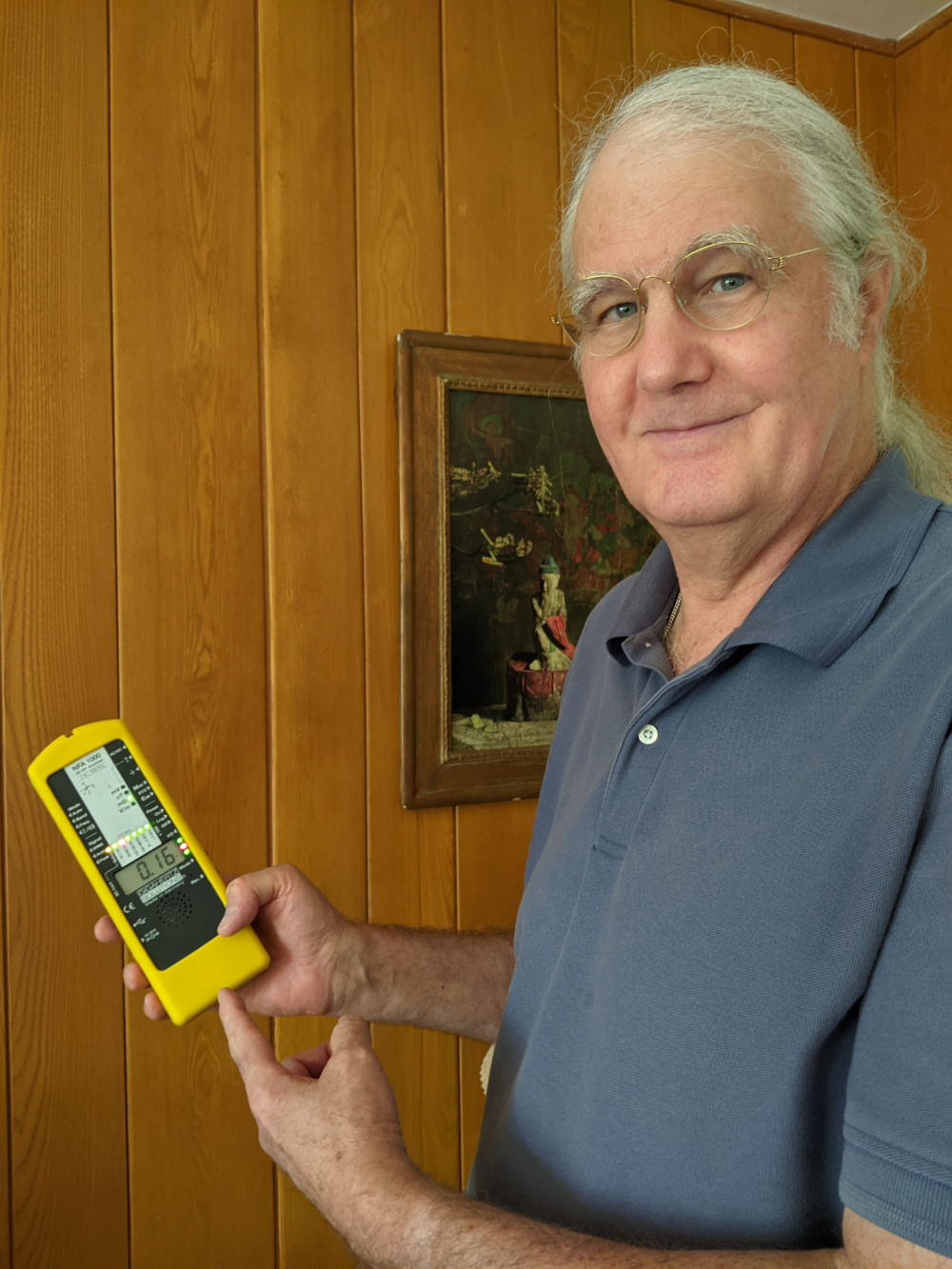
BBEC, EMRS, Certified Building Biology™ Environmental Consultant and Electromagnetic Radiation Specialist and Healthy New Building and Remodeling Consultant. Providing On-Site EMF Evaluations for Existing and New Homes and Offices in Los Angeles, Orange, Ventura, Riverside and San Diego Counties and Nationwide by Telephone and Skype. Based upon the principles of Building Biology™.

